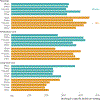Structural Racism And Black Women's Employment In The US Health Care Sector
- PMID: 35130061
- PMCID: PMC9281878
- DOI: 10.1377/hlthaff.2021.01400
Structural Racism And Black Women's Employment In The US Health Care Sector
Abstract
The objective of this study was to describe how structural racism and sexism shape the employment trajectories of Black women in the US health care system. Using data from the American Community Survey, we found that Black women are more overrepresented than any other demographic group in health care and are heavily concentrated in some of its lowest-wage and most hazardous jobs. More than one in five Black women in the labor force (23 percent) are employed in the health care sector, and among this group, Black women have the highest probability of working in the long-term-care sector (37 percent) and in licensed practical nurse or aide occupations (42 percent). Our findings link Black women's position in the labor force to the historical legacies of sexism and racism, dating back to the division of care work in slavery and domestic service. Our policy recommendations include raising wages across the low-wage end of the sector, providing accessible career ladders to allow workers in low-wage health care to advance, and addressing racism in the pipeline of health care professions.
Figures


Similar articles
-
Women's work and development in Latin America.Stud Comp Int Dev. 1985 Spring;20(1):3-30. doi: 10.1007/BF02718316. Stud Comp Int Dev. 1985. PMID: 12267374
-
Intercountry comparisons of labor force trends and of related developments: an overview.J Labor Econ. 1985 Jan;3(1 Pt 2):S1-32. doi: 10.1086/298074. J Labor Econ. 1985. PMID: 12267645
-
The occupational status and wages of women in the USSR.Sov Soc. 1987 Winter;26(3):67-81. doi: 10.2753/sor1061-0154260367. Sov Soc. 1987. PMID: 12280861
-
Economic effects of recent immigration on American workers.Migr World Mag. 1988;16(1):7-15. Migr World Mag. 1988. PMID: 12342180
-
Flames of transformation: Igniting better mental and physical health for racialized and gendered North Americans.Front Glob Womens Health. 2023 Feb 13;4:1126934. doi: 10.3389/fgwh.2023.1126934. eCollection 2023. Front Glob Womens Health. 2023. PMID: 36860346 Free PMC article. Review.
Cited by
-
Diagnostic et prise en charge de la fausse couche précoce.CMAJ. 2025 Jan 12;197(1):E18-E25. doi: 10.1503/cmaj.231489-f. CMAJ. 2025. PMID: 39805645 Free PMC article. Review. French. No abstract available.
-
Characteristics of healthcare personnel with SARS-CoV-2 infection: 10 emerging infections program sites in the United States, April 2020-December 2021.Infect Control Hosp Epidemiol. 2024 May 21;45(9):1-9. doi: 10.1017/ice.2024.71. Online ahead of print. Infect Control Hosp Epidemiol. 2024. PMID: 38770586 Free PMC article.
-
Work as a social determinant of maternal health: A qualitative exploration of college-educated Black women's experiences at work during pregnancy and postpartum.Womens Health (Lond). 2024 Jan-Dec;20:17455057241304842. doi: 10.1177/17455057241304842. Womens Health (Lond). 2024. PMID: 39629770 Free PMC article.
-
Health Care Organization Policies for Employee Safety and COVID-19 Pandemic Response: A Mixed-Methods Study.J Occup Environ Med. 2023 Jan 1;65(1):1-9. doi: 10.1097/JOM.0000000000002741. Epub 2022 Oct 28. J Occup Environ Med. 2023. PMID: 36317257 Free PMC article.
-
Eliminating Disparities in Cardiovascular Disease for Black Women: JACC Review Topic of the Week.J Am Coll Cardiol. 2022 Nov 1;80(18):1762-1771. doi: 10.1016/j.jacc.2022.08.769. J Am Coll Cardiol. 2022. PMID: 36302590 Free PMC article. Review.
References
-
- Centers for Disease Control and Prevention. Coronavirus disease 2019 (COVID-19) in the U.S. Atlanta (GA): CDC; [cited 2021 Dec 16]. Available from: https://www.cdc.gov/coronavirus/2019-ncov/cases-updates/cases-in-us.html
-
- Glenn EN. Forced to care: coercion and caregiving in America. Cambridge (MA): Harvard University Press; 2010.
-
- Duffy M Making care count: a century of gender, race, and paid care work. New Brunswick (NJ): Rutgers University Press; 2011.
-
- Hess C, Hegewisch A. The future of care work: improving the quality of America’s fastest-growing jobs. Institute for Women’s Policy Research; 2019. Sep 23 [cited 2021 Dec 16]. Available from: https://iwpr.org/iwpr-issues/esme/the-future-of-care-work-improving-the-...
Publication types
MeSH terms
Grants and funding
LinkOut - more resources
Full Text Sources

